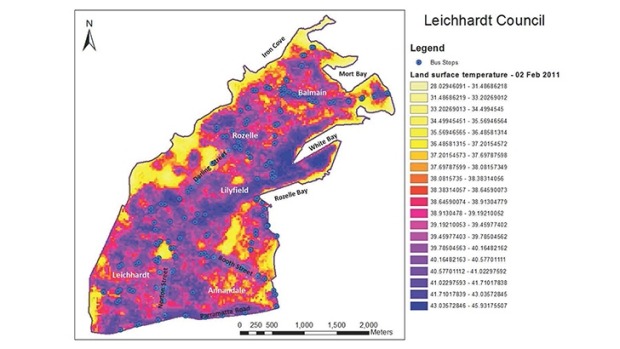Deathly effect of heatwaves ignored

A mosaic of hot spots in the Leichhardt area of Sydney. Photo: Courtesy of ISF
Heat is an emerging problem in Sydney, but despite having its strongest effects on the poor, the elderly, the disabled and the very young, most community services don't formally cater for the impact of heatwaves on vulnerable people.
Heatwaves kill more Australians than all other natural events combined – and they're becoming hotter, longer and more frequent, according to a Climate Council report which says last year was the country's third hottest. As temperatures rise, understanding and mitigating the impact of heatwaves is becoming a pressing issue.
Dr Brent Jacobs and Candice Delaney, researchers at the Institute for Sustainable Futures (ISF) at the University of Technology, Sydney (UTS), teamed up with Leichhardt and Penrith councils to map surface temperatures in the two local government areas and identify local "hot spots" where temperatures can be up to 10 degrees higher than in surrounding areas.
Using a tool developed by the US Department of Agriculture which extracts data from Google Earth satellite images, ISF researchers last year analysed patterns of tree cover in 139 local government areas of Australia, in a project with Horticulture Australia's 202020 Vision project (20 per cent more green space in urban areas by 2020).
Sydney's northern, north-western and south-eastern suburbs had the highest percentages of tree canopy cover, and a low-coverage corridor stretches from the eastern suburbs along Parramatta Road and the Great Western Highway to the base of the Blue Mountains.
"Sydney's new growth centres won't improve the amount of green space in these zones," Dr Jacobs warns.
The team overlaid tree canopy coverage maps with CSIRO records which had processed Landsat images showing surface temperatures on an extreme-heat day in February 2011, so they could identify the location and severity of hot spots.
They found an extensive network of severe hot spots, with community hubs such as schools, town centres, bus stops and high-density residential areas often located in urban heat islands.
In Penrith, the hottest five areas – which ranged from 43 to nearly 60 degrees during a heatwave – were also those with the biggest proportion of vulnerable community members.
"The second part of this research involves doing some 'ground truthing' so we can identify some of the causes and come up with some recommendations about how councils might address these areas," Dr Jacobs says.
"In Penrith, that might involve planting trees along street verges or in open space areas, but places like Leichhardt and Balmain, where there's not much space for more trees, we can look at things like changing surfaces, putting vegetation in as green walls and green roofs."
Leichhardt councillor Darcy Byrne says information from surface temperature mapping is hugely valuable for councils.
"This gives data and evidence for councils like us and like Penrith to be able to talk to our residents about the impacts of climate change and what it's doing right now, in a practical and concrete way," Byrne says.
"Going out and lecturing voters about the intangible impacts of climate change has not traditionally been a successful strategy."
Data on surface ground temperatures in the Leichhardt municipality shows that land in the bays precinct (around White, Rozelle and Blackwattle bays), where the state government proposes 16,000 homes be built, is up to 15 degrees higher than in nearby streets.
Byrne says that such high-density residential development risks creating more urban hot spots and that significant new green open space and tree canopies must be included in redevelopment.
In Penrith, mayor Ross Fowler says the council has committed to having its Cooling the City strategy in place by July "to address the issue of urban heat islands".
Many vulnerable groups live in heat-exposed areas, Dr Jacobs says, but susceptibility to heat is not considered in community assistance programs. "We address mobility with ramps and guardrails but we've dealt with heat by whacking in an air-conditioner – and people in these groups often can't afford the extra electricity," he says.
He says governments need to think about heat as an emerging issue for vulnerable community groups.
Bushfire risks have caused "tree hysteria" – dissuading councils from planting, Dr Jacobs says. "But in these areas, the heat kills far more people than bushfires and storm damage put together."
He says improvements should involve developers. "To future-proof communities against rising urban heat, we've got to stop building housing developments that end up 10 degrees hotter than the surrounding areas."
He says air-conditioners stop project homes evolving. "Even though we know how to build homes that incorporate passive cooling, we still fail to use landscaping effectively and we put dark-coloured tiles on roofs."
Penrith and Leichhardt councils received $67,000 in funding under the NSW government Building Resilience to Climate Change grants to develop strategies for adapting to urban heat, after a pilot study was conducted.
In Penrith, Fowler cites light-coloured pavements and roofs as part of a long list of cooling strategies, which could include tree planting, irrigation and water features in parks, shade and water-sensitive urban design.
Original article: The Sydney Morning Herald




